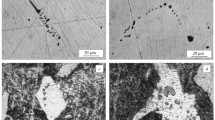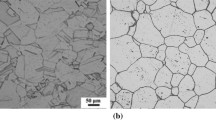The possibility of creation of new competitive materials providing long-term and reliable operation of base members of heavy lifting and conveying machines operating under conditions of intense wear and impact loads at normal and negative temperatures is investigated. A thermokinetic diagram of decomposition of supercooled austenite is plotted for the newly developed steel 16GNTRA sparingly alloyed with elements of the Mn – Ni – Ti – B system. The effect of different heat treatments on the microstructure and mechanical properties of the steel is studied by scanning and transmission electron microscopy. The suggested mode of heat treatment of rolled products from sparingly alloyed steel 16GNTRA provides a hardness of 380 HBW and cold resistance KCV – 40 ≥ 21 J/cm2.





Similar content being viewed by others
References
V. N. Nikitin, S. Yu. Nastich, L. A. et al., “High-strength steels with sparing alloying for mining transport and extracting industry,” Stal’, No. 10, 57 – 66 (2016).
M. V. Chukin, P. P. Poletskov, D. G. Nabatchikov, et al., “Analysis of performance specifications for ultra-cold-resistant rolled sheets,” Vestn. Yuzhno-Ural. Gos. Univ., Ser. Metall., 17(2), 52 – 60 (2017).
M. V. Chukin, V. M. Salganik, P. P. Poletskov, et al., “Main kinds and ranges of application of strategic high-strength sheet rolled products,” Vestn. Magnitogorsk. Gos. Tekh. Univ. Im. G. I. Nosova, No. 4, 41 – 44 (2014).
S. Novák and J. Mráèek, “The experience from welding of high-strength fine-grained steels,” in: Proc. 1st Int. Conf. Recent Trends in Structural Materials COMAT 2010 (2010), pp. 34 – 43.
M. V. Nikitin, V. M. Maslyuk, and N. V. Liz’ko, “Raising the wear resistance of structural steels due to metallurgical production factors,” Metallurg, No. 1, 45 – 47 (2010).
“Wear-resistant sheet steel HARDOX in the mining industry,” Gorn. Prom-st’, No. 4, 58 – 59 (2001).
G. F. Tarasov and A. I. Gorbulya, “Heat treatment of steels as a factor for raising their resistance at low temperatures,” Vestn. Sibir. Gos. Aerokosm. Univ. Im. Akad. M. F. Reshetova, No. 3, 253 – 257 (2005).
L. G. Korshunov, A. V. Makarov, and N. L. Chernenko, “Structural aspects of the wear resistance of steel of martensitic class,” Fiz. Met. Metalloved., 78(4), 128 – 146 (1994).
P. V. Shilyaev, D. V. Bogach, M. L. Krasnov, et al., “Mechanical properties and structural state of rolled sheets from highstrength wear-resistant weldable steel H500 MAGSTRONG,” Metalloved. Term. Obrab. Met., No. 11(785) (2020).
B. Ahlblom, P. Hansson, and T. Narstrom, “Martensitic structural steels for increased strength and wear resistance,” Mater. Sci. Forum, 539 – 543, 4515 – 4520 (2007).
S. C. Kennett and K. O. Findley, “Strengthening and toughening mechanisms in martensitic steel,” Adv. Mater. Res., 922, 350 – 355 (2014).
A. Kern and U. Schriever, “Niobium in quenched and tempered HSLA-steels,” in: Recent Advances of Niobium Containing Materials in Europe, Proc. Symp. 30 Years Annivers. of Niobium Products Company GmbH, Dusseldorf, 20 May, 2005, Verlag Stahleisen GmbH, Dusseldorf (2005), pp. 109 – 119.
P. P. Poletskov, O. A. Nikitenko, A. S. Kuznetsova, and V. M. Salganik, “The study of transformation kinetics for overcooled austenite of the new high-strength steel with increased cold resistance,” CIS Iron Steel Rev., 19, 56 – 59 (2020).
N. V. Koptseva, M. V. Chukin, and O. A. Nikitenko, “Use of the Thixomet PRO software for quantitative analysis of the ultrafine-grain structure of low- and medium-carbon steels subjected to equal channel angular pressing,” Metal Sci. Heat Treat., 54(7 – 8), 387 – 392 (2012).
P. P. Poletskov, M. S. Gushchina, D. Yu. Alekseev, et al., “A study of the effect of modes of controlled rolling of pipe steel on the structural state of hot-deformed austenite,” Vestn. Magnitogorsk. Gos. Tekh. Univ. Im. G. I. Nosova, 16(3), 67 – 77 (2018).
V. D. Sadovskii, Retained Austenite in Hardened Steel [in Russian], Nauka, Moscow (1986), 113 p.
D. A. Mirzaev, K. Yu. Okishev, V. M. Schastlivtsev, and I. L. Yakovleva, “Kinetics of formation of bainite and pack martensite. I. Allowance for the structure of a pack,” Fiz. Met. Metalloved., 90(5), 55 – 65 (2000).
K. Andrews, D. Dyson and S. Kyown, Electron Diffraction Patters and Their Interpretation [Russian translation], Mir, Moscow (1971), 256 p.
S. A. Golosienko, “Novel high-strength cold-resistant steels for Arctic applications,” Proizvod. Prokata, No. 2, 17 – 24 (2014).
Author information
Authors and Affiliations
Corresponding author
Additional information
Translated from Metallovedenie i Termicheskaya Obrabotka Metallov, No. 11, pp. 32 – 37, November, 2021.
Rights and permissions
About this article
Cite this article
Poletskov, P.P., Yakovleva, I.L., Koptseva, N.V. et al. A Study of the Structure and Properties of Novel Cold-Resistant High-Strength Steel for Operation Under Conditions of Intense Wear. Met Sci Heat Treat 63, 606–611 (2022). https://doi.org/10.1007/s11041-022-00736-7
Published:
Issue Date:
DOI: https://doi.org/10.1007/s11041-022-00736-7




